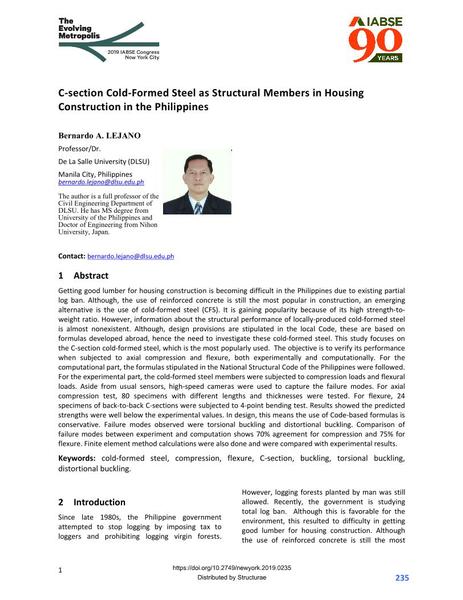C-section Cold-Formed Steel as Structural Members in Housing Construction in the Philippines

|
|
|||||||||||
Bibliographic Details
| Author(s): |
Bernardo A. Lejano
(De La Salle University (DLSU))
|
||||
|---|---|---|---|---|---|
| Medium: | conference paper | ||||
| Language(s): | English | ||||
| Conference: | IABSE Congress: The Evolving Metropolis, New York, NY, USA, 4-6 September 2019 | ||||
| Published in: | The Evolving Metropolis | ||||
|
|||||
| Page(s): | 235-240 | ||||
| Total no. of pages: | 6 | ||||
| DOI: | 10.2749/newyork.2019.0235 | ||||
| Abstract: |
Getting good lumber for housing construction is becoming difficult in the Philippines due to existing partial log ban. Although, the use of reinforced concrete is still the most popular in construction, an emerging alternative is the use of cold-formed steel (CFS). It is gaining popularity because of its high strength-to- weight ratio. However, information about the structural performance of locally-produced cold-formed steel is almost nonexistent. Although, design provisions are stipulated in the local Code, these are based on formulas developed abroad, hence the need to investigate these cold-formed steel. This study focuses on the C-section cold-formed steel, which is the most popularly used. The objective is to verify its performance when subjected to axial compression and flexure, both experimentally and computationally. For the computational part, the formulas stipulated in the National Structural Code of the Philippines were followed. For the experimental part, the cold-formed steel members were subjected to compression loads and flexural loads. Aside from usual sensors, high-speed cameras were used to capture the failure modes. For axial compression test, 80 specimens with different lengths and thicknesses were tested. For flexure, 24 specimens of back-to-back C-sections were subjected to 4-point bending test. Results showed the predicted strengths were well below the experimental values. In design, this means the use of Code-based formulas is conservative. Failure modes observed were torsional buckling and distortional buckling. Comparison of failure modes between experiment and computation shows 70% agreement for compression and 75% for flexure. Finite element method calculations were also done and were compared with experimental results. |
||||
| Keywords: |
buckling torsional buckling cold-formed steel C section compression distortional buckling flexure
|
||||
